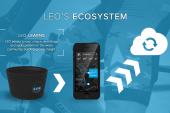
Movers and Starters is an exclusive series that profiles the individuals who drive Toronto’s startup community.
Give us an introduction to yourself.
I’m the co-founder and CEO of Wave. I started the company with my partner James Lochrie. We’ve been around for about two-and-a-half years, and in that time we’ve seen really good traction in a difficult to reach small business market.
You started two outdoorsy type startups, AdvertureLifestyle.com and Outdoorsica.com, before founding Wave. I’d like to know how one goes from starting those two startups to a more accounting-based startup?
Well, I’ve always been interested in the outdoors, and I did a lot of outdoor adventure stuff in my late teens to early twenties, so it was a natural fit for me to go into starting those two companies when I did. Although the interesting thing is that I almost always found myself behind the camera or negotiating some kind of deal, so in a way, founding AdventureLifestyle.com and Outdoorsica took me away from my outdoor pursuits rather than add to them.
The second one, Outdoorsica.com, was a part-time project. My partners and I thought that vertical social networks were far more interesting than broad social networks–and you’re starting to see that play out right now. The experience of starting Outdoorsica taught me that you can’t do something part-time and expect big results, especially when you’re working with engineers and developers. If they’re doing programming work for another company during the day, then their desire to do it again for you in the evening is going to be a struggle, and rightfully so, they need some time to decompress.
When James and I started talking about Wave, it was around the fact that, having been a small business owner myself, I knew the pain of this really large market. All of this back office stuff absolutely sucks for most businesses. So it was a desire to solve that pain point–one that I had experienced myself a couple times over–that got me interested in the space. It was less about the nuances and desire to get into accounting, payroll, and the rest of it, and more so about how we could automate some of those things so small business owners had more time to do what they love.
Do you mind telling us more about AdventureLifestyle.com? You were streaming video before Youtube even existed.
Yeah, so what a fascinating time it was to start a business like that. We started in 1997 and went bankrupt in 2000. Looking back, the technology 13 to 14 years ago made things really interesting. Photographing a mountain bike race back then meant pressing the button to take the photo when the rider was 50 meters away; you had to press the button on the camera that far away because it took that long for a digital camera to take the picture. We had to carry around these 10 to 12 pound laptops and a briefcase with a satellite phone to upload the photos from areas that didn’t have cellphone coverage. The satellite phone would upload photos at 2.5 kilobyte per second, and while the photos were usually only 25 kilobytes big, the connection would almost always conk out three-quarters of the way through the upload. It’s funny to think how far technology has come in such short amount of time.
We did some interesting things. For instance, we had exclusive rights to some large scale events, we had a deal in place with Windows Media Player where they were streaming some of our content, and we even contributed some content to the Canadian version of National Geographic.
Going into starting Wave, what did the experience of starting your previous two companies teach you?
When I look back at the AdventureLifestyle, it was kind of how I got my MBA the hard way. I dropped out of university twice. I was never an in-classroom learner, so starting the company gave me an opportunity to test my assumptions and to make a lot of mistakes while learning from them. It was there that I also learned the pros and cons of doing business with friends.
For my second company, the biggest thing I learned was what I already mentioned, which was the part-time thing. When we started Wave, I decided early on to quit my day job. I had two children already and another one on the way, a mortgage to pay off, and a wife that was about to go on maternity leave, so I had to set it up so I had some kind of income coming in, but soon after I decided that Wave was something that I wanted to put all my energy into, so decided to go at it full-time. James made the same decision soon after that.
If you want to truly build something big and build it for the long term, then at some point, when it’s right for you, you have to get off the sidelines and say that you’re all in, and you have to surround yourself with people who share that same mindset.
What made you and James decided to go into such a competitive market, especially in Toronto where companies like Freshbooks are so successful in the space? Also, what are some things that differentiate Wave from its competitors?
The first and most important thing is that we’re exclusively focused on helping companies with nine employees or less. What’s interesting is that 94 per cent of all businesses in North America fit into that range, but most of the companies building business software solutions either start in the small business space and move up market, or they start mid market and stay there, so most of those 94 percent of businesses aren’t being well looked after by software companies.
They’re also forced to struggle with a mix of consumer and enterprise-grade software–a lot of what they’re using day-to-day are applications like Gmail and Dropbox. Most of them are not using tools like Salesforce or other much larger enterprise applications.
It takes a different mindset to design and build tools for this market: You have to build applications that leverage the best of the consumer world, but that are at the same time bulletproof enough to be ready for business. It’s obviously very different building an accounting tool that has to balance an account versus building a photo sharing tool. Twitter can get away with being down every hour, but that doesn’t fly when you’re building a tool that business owners rely on to help run their business. So the difficulty is that you have to try and balance creating an app that is as easy-to-use and understand as Gmail, but one that is as reliable and dependable as Apple’s OS X.
So that was the first thing–a very specific focus on a very specific part of the market. We get asked a lot whether we will move up market, but I think we will always focus on this market.
Secondly, what we’ve found is that, while the concept of an open web is great, it doesn’t make sense in certain verticals and niches. In this space, a small business owner has to stitch together a bunch of different applications in order to get what they need. If they’re looking for something to help them with invoicing, making payments, accounting, payroll management, and receipt scanning, they have to pick a bunch of different solutions and try to put them together through an API. Most small business owners are constrained for time. So one of our core ambitions was to build an integrated tool that lets them, among a lot of other things, manage double entry accounting, send out invoices, accept credit card payments right from their invoices, scan their receipts, and do their payroll all in one application. In short, a tool that is robust enough to support a growing business.
No matter what business you own, there is a really stressful event down the pipe that is tax time. If you see a small business owner around that time, they usually have a look of fear and anxiety in their eyes. It’s a moment of reflection when they say to themselves, “Wow, I wish I would have taken better care of this during the year so that this was easier.” That’s the specific pain point we’re trying to fix.
Can you talk a bit about your co-founder, James, and what he’s brought to the company?
Obviously, the first thing to note here is that Wave isn’t just about James and I anymore; It’s about 70 people, and the exciting thing is watching them help evolve what is possible far beyond anything we’ve ever imagined.
In terms of James, our wives went to university together, so they’re the glue that brought us together. I met James about 13 years ago and we became friends quickly. In a lot of ways, we see the world in the same way. He’s a bit older than me, so he had his kids earlier than I did. But when my wife and I started to have our kids, it was a great opportunity to hang out with another family.
Both of us got to the same place at relatively the same time where we said to ourselves, “We don’t want to work for somebody else anymore.” We thought about a lot of different ideas, and Wave was the idea that came together in terms of being the place where our idea best matched what our skills sets were. My experience of having been an entrepreneur and building tech teams for print media companies moving to online, paired with James’ experience at a tax preparation firm working with hundreds of small businesses and running all of their custom IT software, made us think we could go after this market.
You mentioned before that you learned the pros and cons of starting a business with a friend–and with Wave you find yourself starting a new business with a good friend. What are those pros and cons, and what made you decided to work with a friend again?
Obviously this goes without saying, but the biggest potential con is that you have to go into it knowing that if things go wrong that you’re potentially sacrificing your friendship. I think almost everyone’s immediate knee jerk reaction is to want to go into business with their friends–you trust your friends, you can talk to them, and it’s comfortable. The downside is that most people don’t think about the fact that most businesses will go south. You’re essentially gambling your friendship against the desire to do business with your friends.
The pro is that going into business with a friend can lead you to have even more respect for them. I can certainly say that I respect James even more now than I even did when we just friends.
Startups always go through peaks and valleys, but we’ve made it through those peaks and valleys with more respect for one another. So I think, if anything, the pro is that it can cement your friendship. If you and your co-founders have complementary skill sets, then you’re business is going to be more valuable as a result.
You said before that you have three young kids–how have you tried to balance your home life with what you’re doing here at Wave?
It’s obviously a dilemma and a struggle, and it’s something I think about all the time–am I doing enough on both sides of the equation?
Thankfully, I live quite close to the office, so I don’t have an hour commute on top of long hours at the office. Secondly, because I have children and James has children as well, we’ve created a pretty good life work balance at the office where we expect our employees to work hard, but we also understand how important their home lives are. If people aren’t centred around their home, then it’s likely that there’s going to be some unhappiness in their lives and that’s probably going to lead to their productivity dropping.
As for my own situation, the first thing is that you have to have a supportive partner who has bought into why you’re doing this; why, if you weren’t doing it, you would be unfulfilled; and how that’s probably worse than someone who is fulfilled but working hard.
Secondly, what I’ve tried to do is to bring my kids into the loop of why I’m doing this and what I’m doing. We have family events here at Wave where everyone at the company brings their significant other and kids if they have them. There’s an extended family that gets created through that.
Wave has been fortunate to secure a number of investors. With those investors coming on board, has there ever been pressure to move the company to the States?
The days of companies that are achieving scale being pressured or forced to move to the Valley are gone. That’s obviously a great thing for the ecosystem in Toronto. There are more US investors coming to Canada, and there are more companies like Wave, Wattpad, and TopHat attracting them here. Investors don’t just fly up to Toronto to attend their board meetings, they want to surround those meetings with other meetings and visits to other great companies. I think that’s great for our up-and-coming entrepreneurs. I also think there’s a growing understanding that, while acquiring and retaining engineering talent in Toronto is becoming more difficult, it is nowhere near as difficult as it is in the Valley. So there’s a huge advantage to companies being based here.
The only thing our ecosystem needs to continue to develop is really seasoned sales, marketing, and operations type individuals–people who have done this at scale a couple of times already, and who can come into businesses like ours and help take us to the next level. That’s an area where the more the tech scene gets bigger, the more it starts to spin out successful exits or IPO’s, creating a compounding effect.
What’s next for you and the company?
We’ll continue to focus on our customers and how we can make their businesses more successful when they use our products. As long as we continue to do that the rest will take care of itself.
____
Igor Bonifacic is a writer working for the Toronto Standard. You can follow him on twitter @igorbonifacic.
For more, follow us on Twitter @TorontoStandard and subscribe to our newsletter.














